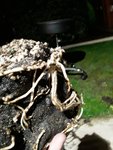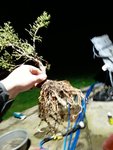I had someone request a type of list of things that can be answered rather than having a bunch of anecdotes to try and pull everything from. Here is a list of things I thought could be answered, if anyone has other things to add lmk. Also why can't I seem to edit my initial post? I thought I could do that...
What is the tree species?
What month did you collect in?
Where are you located?
Where did you collect from (altitude, humidity conditions, temperatures, etc.)?
What differences between the collection area and the recovery area were there (humidity, wind, sun, temperature, seasonal difference, etc.)?
Have you previously collected this species successfully?
Was there rain in the previous month before collection?
Was this a planned collection or an opportunity-based collection?
Did you specifically choose Fall collection over Spring collection?
Was the tree bare rooted from collection?
Was the root ball mostly undisturbed or was it dug up and severely disturbed?
What % of the roots did you remove/prune (if any, mostly talking about potting it up or balancing of roots to foliage)?
Did you submerge the tree in water at all (If so, how long and any care like changing out the water, etc.)?
What was the soil type of the collection area (compacted desert dirt, wet highly organic, near a stream, sandy, etc.)?
Aftercare:
What was the tree planted/heeled in?
How often was the tree watered (or what indicator did you use to water)?
Was the tree protected from wind (if so how)?
Was the tree protected from freezing temperatures (if so how)?
Was the tree put in full sun, partial sun, or full shade (elaboration is great if needed)?
Was the tree placed on the ground in its post-collection container?
Did you experience any cold damage that became visible in the Spring (dieback, root damage)?
Deciduous:
Was the tree in leaf?
If so, had the leaf color changed before collection?
Did you defoliate/partially defoliate/prune to balance root:shoot ratio?
Did the leaves drop off the tree if you didn't defoliate and regrow new leaves?
Broadleaf Evergreen:
Was the tree in leaf?
Did you defoliate/partially defoliate/prune to balance root:shoot ratio?
Did the leaves drop off the tree if you didn't defoliate and regrow new leaves?
Conifer and Evergreen:
Was any foliage taken off or pruned at all?
Did you mist regularly during the recovery process (mostly for Junipers)?
Did you lose any needles or foliage?
Hi
I collect almost whole year around, including June, July, August, September etc. , my teacher has been doing the same on a much bigger scale for years.
Tree species are mostly wild olives, phillyrea angustifolia and myrtle, but also junipers and others.
I will talk about olives since I'm more experienced in those
I'm from Sardinia island, Italy (zone 9/10)
Collecting from anywhere from sea level to 1000 meters (best specimens are usually found near sea level)
Sometimes it does not rain for a month before collection, no big deal
I collect the tree with almost no root at all, always bare rooted, usually I just dig enough to cut at the main root and pull out the plant, and that's it!
Defoliate fully on the spot and prune, sometimes very drastically, or partially on the spot and the rest at home.
I wrap the roots with wet clothes and plastic, bag the whole tree and keep it wet until i get home.
When I'm home I submerge the tree and defoliate, until next day or the day after.
Plant in full pomice in wooden boxes or big plastic pots with added holes, moss on top all around the trunk
I water with some Radifarm added and put the tree in a dedicated greenhouse, on the floor
Greenhouse has a shade cloth and a misting system, I keep humidity EXTREMELY high (key point)
Some Radifarm again after 10 days and that's it
No need for watering at that point,
new growth starts very soon and you can see roots everywhere, even aerial roots
when new growth is about 10cm long I pull the plant out in full morning sun,
watering depends on how vigorous the plant is, can be everyday, can be once a week.
After 2 months from collection I usually get 30cm long new shoots








